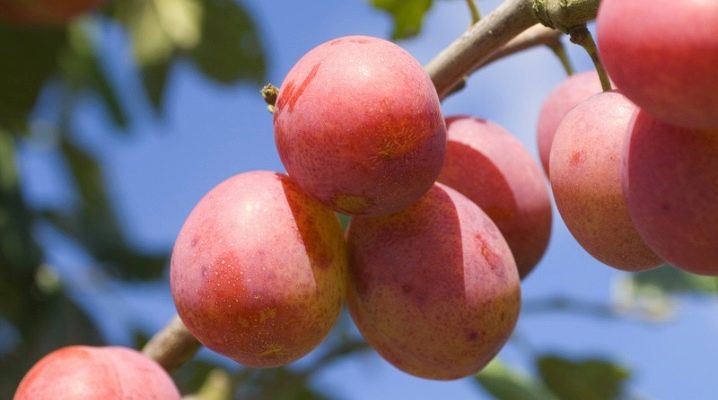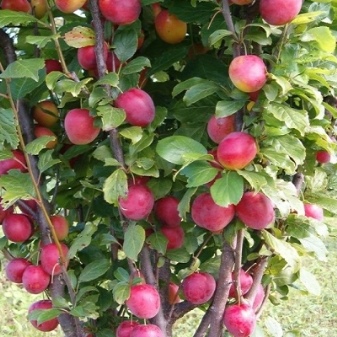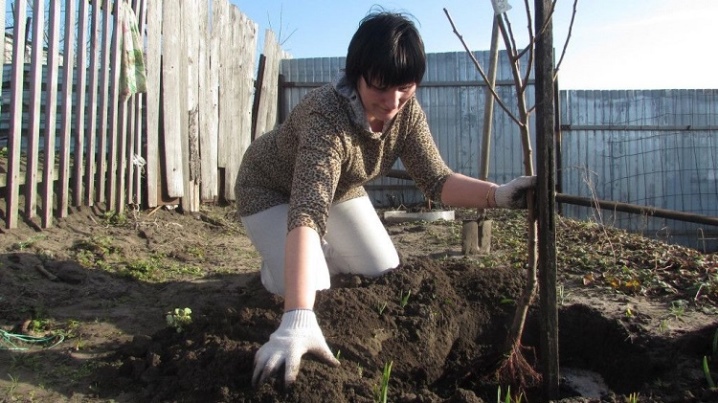Description and care of the sharafuga

Summer has come - it's time to taste ripe juicy fruits. Shop shelves are littered with various types of them, including exotic ones. I always want to try new varieties. One of them is the sharafuga.
This fruit tree is a hybrid variant obtained after crossing other stone fruit species. Today we will talk about how a sharafuga looks, how to grow a plant, care and reproduction.


What it is?
Those who want to get acquainted with an unusual hybrid resulting from crossing an apricot, a plum and a peach should study this material. Sharafuga is also called nectakotum in another way; this fruit plant is in high demand among gardeners. This is due to the fact that this culture has excellent taste characteristics, while it has high frost resistance and rather early ripening of the crop.
But in order to grow a hybrid on your site, you need to know what the sharafuga is, what the height of the tree is, and also figure out how to plant and care for the plant in the future.

Description
Sharafuga is a single-stemmed crop with a spreading crown of medium density. The tree can grow up to 3-4 meters in height. Each year, the shoots of the plant are able to grow by 70 cm. Since the "parents" of the tree are plum, apricot and peach, it inherited their features. Outwardly, the hybrid is similar to a plum; there are thorns on its branches. Its leaves have the curliness inherent in a peach, and the shape of the fruit is similar to an apricot. Sharafuga leaves outwardly resemble a plum, similar to an apricot in the color of the bark and the location of skeletal branches. Large fruits usually reach sizes up to 7 cm.
Ripe fruits are very juicy and have a light apricot aroma. The pulp itself has a pleasant sweet taste, perceptible notes of peach and even banana. The skin is slightly sour, reminiscent of the taste of a plum. The skin of the fruit has a different color, which directly depends on the variety, as well as on the ripeness of the fruit. Its stone is outwardly similar to peach, but has a less pronounced pattern. It separates easily, which is very convenient when eating fruits. The fruit ripens in August-September. This period usually depends on the region where the hybrid is growing. If in warmer zones the harvest begins in August, then in the northern regions this procedure is carried out later, not earlier than September. Ripe fruits do not fall off. They should be removed from the tree with your hands, do not shake it, otherwise the fallen fruit may be damaged and start to deteriorate soon. It is better to harvest on time, otherwise birds will begin to peck it. Jays especially love to feast on juicy fruits.
Fresh fruits are used for preparations. They make delicious aromatic jam, vitamin compotes. Plucked fruits can be transported over a long distance, they tolerate transportation well. The peculiarity of the culture is that it can be planted even in the central regions of Russia. The plant is able to tolerate small frosts up to - 3 degrees. Due to the relationship with the plum, the tree can withstand frosts down to -25 degrees. In the case of freezing of the shoots, the hybrid is capable of rapid recovery.
The first harvest from a tree can be obtained already in the third year, and by 7-10 years the plant becomes the most fruitful.


Breeding history
Nectacotum is a hybrid of peach, plum and apricot. The idea to create such a "mixture" belongs to the American biologist Flod Seiger, who has been trying to develop such a hybrid for 3 decades. In total, the breeder has patented almost 500 different plants with excellent taste during his life. The breeder carried out pollination of crops exclusively by hand, using brushes for cosmetics. Seiger believed that due to the fact that all these crops belong to the plum subfamily, they can be crossed among themselves. The result is a crossed culture that is not capable of propagating by seeds.
The breeder managed to breed a fruit tree that has many positive qualities:
- the hybrid gives good yields;
- the fruits of the plant have excellent taste characteristics;
- the culture is resistant to frost and many diseases;
- fruits are well stored, have high transportability.
Also, the positive characteristics include the fact that the fruits of the tree, even in an immature form, are quite tasty. On average, a hybrid bears fruit for 40-50 years. The best pollinators for him are plum or apricot. At the same time, the culture has certain disadvantages:
- exclusively fertile soils are suitable for the growth of a sharafuga;
- requires regular feeding and watering;
- the purchase of seedlings will cost a significant amount;
- inability to obtain seed materials.
Planting early varieties of plum or apricot, which will bloom at the same time as the sharafuga, will help ensure the best fruit set. Growing a hybrid and caring for it is carried out in the same way as growing a plum, peach or apricot, since the sharafuga has inherited all their features. Externally, the seedling can be confused with another tree. A columnar plum looks very similar to a hybrid seedling, so it is important not to make a mistake when choosing a seedling. When buying an original culture, it is advisable to contact specialized nurseries.

Varieties
It is still quite difficult to find this culture on the market today. Of the varieties that were imported from America, you can most often find such.
- Bella Gold variety. It is recommended for home cultivation. The berry of this variety is yellow, the pulp is juicy, fleshy. Although the fruit is similar in appearance to the plum, it tastes much sweeter and more closely resembles an apricot.
- Bella Cerise and Bella Royale. Usually this option is used for commercial purposes.
- Velvet Sunrise. It is not for nothing that the variety has a similar name, since its berry is dark, blue with a plum flavor.
Many people confuse the sharafuga, believing that it is the fruit of nectarine. It is not so easy to find such a hybrid on the market. Usually the culture is presented in two varieties with fruits of yellow and gray-violet hue.


Landing
Planting the sharafuga in the spring is done in a certain way.
- A few weeks before planting, you need to dig a hole and prepare it. To do this, pieces of broken brick or pebbles are laid out on the bottom as drainage in order to prevent stagnation of water.
- Next, you need to drive a stake so that it rises above the ground.
- Next, you need to add a fertile layer, covering it with peat, humus and earth, taken in equal parts.
- A seedling is placed on the prepared soil, straightening the roots.
- They fill the hole with earth and tamp the soil.
- A trunk is tied to a peg.
- Produce abundant watering.
Mulching the near-stem trunk with organic matter will help reduce moisture evaporation and improve the structure of the soil.

A place
The sunny side is considered the best place for planting. The plant will take root better on a hill or out of the blue. It is important to protect the seedling from cold winds, as well as from dampness, otherwise it will lead to the appearance of fungus. For the same reason, it is not recommended to plant the crop in the lowlands.

Timing
Growing in the middle climatic zone is most suitable for a hybrid. In the southern regions, the plant can be planted both in spring and autumn. Before frost, the plant will have time to root well and adapt to changes in temperature and other conditions. In the central and more northern regions, nectakotum is recommended to be planted in spring, choosing for this a well-lit, non-thickened area.

The soil
Having decided on the landing site, it is necessary to prepare the soil for this. To do this, in the fall, they dig up the earth and apply mineral fertilizers with a bucket of humus. As for the soil, the crop will grow better on fertile, breathable and moisture-permeable soils. In the event that the land on the site is acidic, it should be calcified, adding to 1 sq. meter 300 grams of slaked lime.

Care features
Growing a sharafuga outdoors is impossible without proper plant care. Timely watering and fertilization, regular pruning, loosening and pest control will allow you to get a good harvest.
Watering
It is important to regularly monitor soil moisture by watering. When watering a hybrid, remember that the procedure is carried out using warm water. When irrigating a crop, make sure that the soil on the upper layers is evenly dried out, otherwise excessive moisture can lead to rotting of the root system. The amount of water and the frequency of the procedure depends on the weather.
In the spring, with frequent rains, watering can be omitted. This is done only on hot days. In dry years in the spring, it is necessary to irrigate the nectakotum several times, increasing the amount of water during irrigation, spending up to 15 liters. The tree does not like excess moisture. It is important that the water reaches the roots, that is, to a depth of about a meter. Sprinkler irrigation is more suitable for this crop.
You can also water the groove by adding 2-3 buckets of water per 1 sq. meter.

Top dressing
Timely feeding will allow to increase the yield and improve the growth of crops.
- Organic matter is introduced into the soil until buds appear on the branches.
- To build up green mass, a nitrogen mixture and ammonium nitrate are used. Drugs are introduced during the formation of the kidneys.
- Potash fertilizers and superphosphates are applied during bud setting.
- To stimulate the ripening of fruits, when they are formed, it is advisable to introduce compounds with calcium, potassium, selenium and manganese into the soil.
The harvest is completed with the introduction of organic fertilizers.


Loosening
When planting a tree, a trunk circle is formed. It is expanded as the culture grows and matures. If it is necessary to retain moisture or when weeds appear, it is advisable to mulch the trunk circle. For this purpose, you can use dry grass, sawdust or needles of coniferous trees.
Loosening of the soil must be done regardless of the use of mulch, this will saturate the soil with oxygen, make it lighter. Such a soil is perfect for plant growth and root development.

Pruning
Considering that the sharafuga grows on average by 60 cm or more per season, it is necessary to carry out the formation by pruning the shoots. It is best to cut the shoots in half, doing this in early spring, before sap flow. Sanitary pruning is also carried out within the specified time frame. At this time, it is necessary to remove dried, cut out broken or diseased branches. In the first year after planting, it is not recommended to trim the sharafura. After this, the side shoots are cut annually. After the procedure, it is better to lubricate the cut site with potassium permanganate or apply paint on drying oil. Then water the bush.
If you cut the branches in the fall, then the tree will not have time to fully recover by the winter frosts. The first frosts after the autumn thinning often lead to the death of the culture. It is necessary to carry out regular crown formation, taking into account the fact that the tree turns out to be spreading, and unnecessary branches can interfere with the correct development of the crown. It is recommended to shorten branches that grow inward and unnecessarily thicken the crown.Once the crop begins to bear fruit, adjusting pruning is done to help maintain the balance between hybrid yield and branch growth.

Pest control
The hybrid has high resistance to pests and various diseases. To get rid of problems when growing a hybrid will allow carrying out certain activities.
- Whitewashing the trunks with a lime mortar, carried out in early spring and autumn, will reduce the likelihood of developing fungal and other diseases, prevent burns and prevent rodent infestations. In this case, it is necessary to whiten not only the trunk, but also the skeletal branches.
- Cleansing the damaged bark, carried out in the autumn, will save the tree from the development of diseases. It is important to collect and burn all the peeled bark. You should also clean the trunk circle by removing residual mulch, fallen leaves or rotten fruits, otherwise the remaining debris can contribute to the appearance of pests and diseases.
- Foliar treatment with garlic or onion solution will help protect against the appearance of pests.
It is worth mentioning that the hybrid has a high resistance to viral diseases; this tree is rarely affected by various pests. When curling appears on the leaves, which is inherent in peaches, or if the leaves on the sharafuga are covered with white spots, fungicide treatment is carried out. Insect infestations use insecticides.


Reproduction
Since nectacotum is a hybrid crop, it is not seed-bred. It can only be propagated by cuttings. The material for this is prepared in the fall.
- It is necessary to cut cuttings with a length of 20 cm. You need to remove the extra leaves and leave 3 buds.
- In winter, they are stored in the refrigerator or used for this purpose with a piece of damp cloth. The cuttings should be planted in a germination container.
- After the cuttings are dipped in Kornevin for a day, then sent to a well-moistened nutrient soil.
- It is important to plant the cuttings at an angle.
- The culture requires timely irrigation and regular moisture.
In open ground, seedlings can be planted in the spring, after the end of the frost. Other crops such as apricots, plums and cherry plums can be grafted onto nektakotum, which many summer residents successfully do.


Gardeners reviews
Since not so many gardeners were able to get acquainted with the sharafuga yet, the reviews about the tree are contradictory. Those who were able to purchase a quality variety from a trusted seller were able to share only positive reviews about the culture. The main requirement for this crop, in their opinion, is timely watering and care. Also important is good soil preparation before planting and the right site selection. If you follow all the recommendations, you can get the first harvest in the second year. For 3-4 years, you can not only taste the first fruits and evaluate their taste, but even make small preparations for the winter. For compotes, it is better to use unripe fruits. Softer fruits are more often eaten fresh. The fruits of the sharafuga are very tasty and unusually juicy. When pressed, juice drips directly from them.
The stone separates well, which is very convenient when eating fresh fruits and for preforms in the form of jam. The taste of the fruit is pleasant. During transportation, fruits do not wrinkle and do not lose their presentation. There are also negative reviews, but they relate to the acquisition of low-quality seedlings. Some time after planting, only small fruits with a non-separating bone were obtained. The taste of such fruits turned out to be incomprehensible, not like plum, apricot or peach. In general, most gardeners believe that the sharafuga will be a real find, especially for lovers of exotic cultures. Proper care and watering will allow you to get juicy fruits that have an interesting taste. You can also learn about hybrid culture by watching a video on the Internet.










The comment was sent successfully.